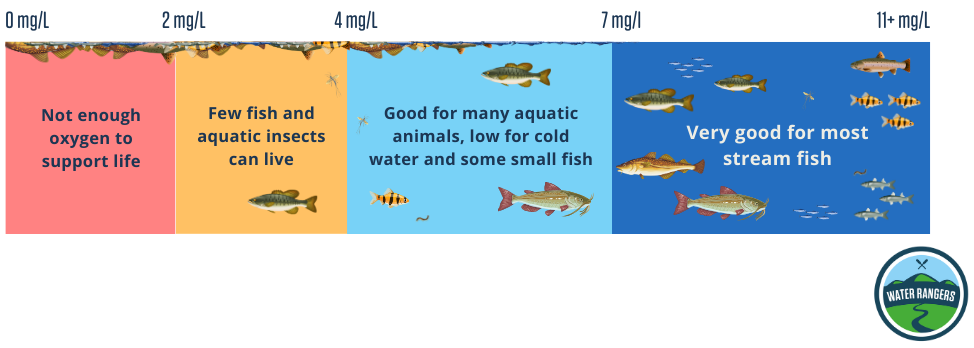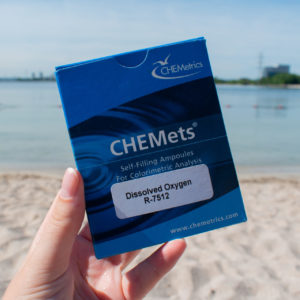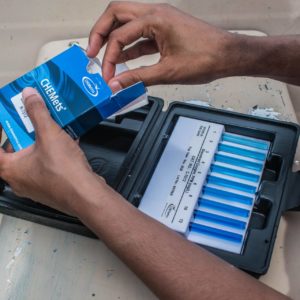Dissolved oxygen
What is dissolved oxygen?
Dissolved oxygen is the amount of gaseous oxygen (O2) present in water. Oxygen dissolves into the water in various ways. It is created by aquatic plants and algae during photosynthesis. Oxygen from the air also dissolves into the surface of the water. Winds and wave activity in lakes and fast-flowing rivers promote the mixing of air and water, increasing the amount of oxygen that dissolves.

Why is dissolved oxygen important?
Oxygen is what gives water life! Even underwater, fish, plants, and other aquatic life depend on oxygen to survive.
What impacts dissolved oxygen levels?
As summer temperatures and algae blooms increase, “dead zones” with scarce oxygen form in the water, creating challenging conditions for fish and other aquatic organisms.
Temperature
The water’s temperature is important when discussing dissolved oxygen. Gasses, like oxygen, dissolve more easily in cold water than at warmer temperatures. During the sweltering summer months, rivers and lakes often experience a drop in oxygen levels, making it harder for aquatic life to survive.
Algae blooms
Excessive nutrients in waterbodies and warmer, longer growing seasons have caused more frequent algae blooms in recent years. During the initial stage of a bloom the algae is growing and photosynthesizing, causing a spike in the dissolved oxygen levels. When the bloom dies, bacteria decompose the algae, using up a lot of oxygen in the water and causing dissolved oxygen levels to plummet.
What does a dissolved oxygen measurement mean?
Dissolved oxygen is commonly measured as a concentration in milligrams/litre. The concentration refers to the amount of oxygen that is dissolved in every litre of water. Each species has a different tolerance for the amount of oxygen that it needs. Though most fish require a moderate value of oxygen in the water, some species require higher levels!
Some common values
| Not enough oxygen to support life | 0 – 2 mg/L |
| Only a few fish and aquatic insects can survive | 2 – 4 mg/L |
| A good range for many aquatic animals, but too low for most cold-water fish | 4 – 7 mg/L |
| Very good for most stream fish and freshwater aquatic life | 7 – 11 mg/L |

Dissolved oxygen can also be measured as a percentage. The percentage refers to the saturation level of oxygen in the water. The key factors in determining saturation are temperature, barometric pressure, altitude, and to a lesser extent, salinity. For example, at sea level:
- 100% saturation at 25℃ = 8.26 mg/L
- 100% saturation at 0℃ = 14.6mg/L
Water Rangers testing protocol
Research
This device has been compared to professional probes with very good results.
We use the Chemetric dissolved oxygen testkit. It is the most user-friendly (no measuring chemicals) and is easier to interpret than other tests we’ve tried! It measures dissolved oxygen in milligrams/litre as a concentration.
While a probe will give you more fine-grain results, we haven’t found inexpensive ones that we thought were as good as this test (plus, they need calibration every time you use them). When you’re recording results, you’re looking to see if results are low, medium, or high. Low oxygen might be found naturally in some ponds and bogs, but usually, low levels are a sign that you have excess nutrients in the water.
How to test dissolved oxygen
- Take out an ampoule and your sample cup. Notice the ridges in the bottom. Notice the white tip on the ampoule. This is a weak point in the glass.
- Take a water sample as far below the surface as you can reach. Do not shake. It is more important to get the sample quickly than to get exactly 25mL.
- IMMEDIATELY put the ampoule, tip down, into the sample. Break the ampoule’s tip off using one of the ridges at the bottom of the sample container by pressing against the ridge and pushing inward. It takes less pressure than you think!
- The ampoule will fill with water. Once mostly filled, remove from the sample and invert two times (watch the bubble travel up/down two times).
- Hold the tip facing upwards for 2 minutes (sand timer/stopwatch).
- Take out your comparison chart. Place the ampoule flat between the comparison chart until you and your testing companion agree on the reading. If it’s between two values, take the halfway point.
- Record your results. Carefully pour water out, leaving the glass tip in your sample cup. Remove the tip and used ampoule and put them in a disposal cup. When you return home, you can dispose of the waste in regular garbage.
- Pack up your kit. Do not expose the comparison chart or ampoules to light except while conducting the test since the dye is affected by sunlight.
Make sure you take out your comparison chart. Pull from the bottom. To put it back in, position it under the top lip first and press downward. On sunny days, find a shady spot to compare results.
Start testing dissolved oxygen with these products:
-
 Dissolved oxygen replacement$99.00
Dissolved oxygen replacement$99.00 -
 Dissolved Oxygen Testkit$148.50
Dissolved Oxygen Testkit$148.50 -
 Freshwater Explorer Testkit$420.00
Freshwater Explorer Testkit$420.00
Contributing to the community!
Water Rangers is citizen-scientist led. So, if you have any questions, ideas, or notice any errors, please tell us!
